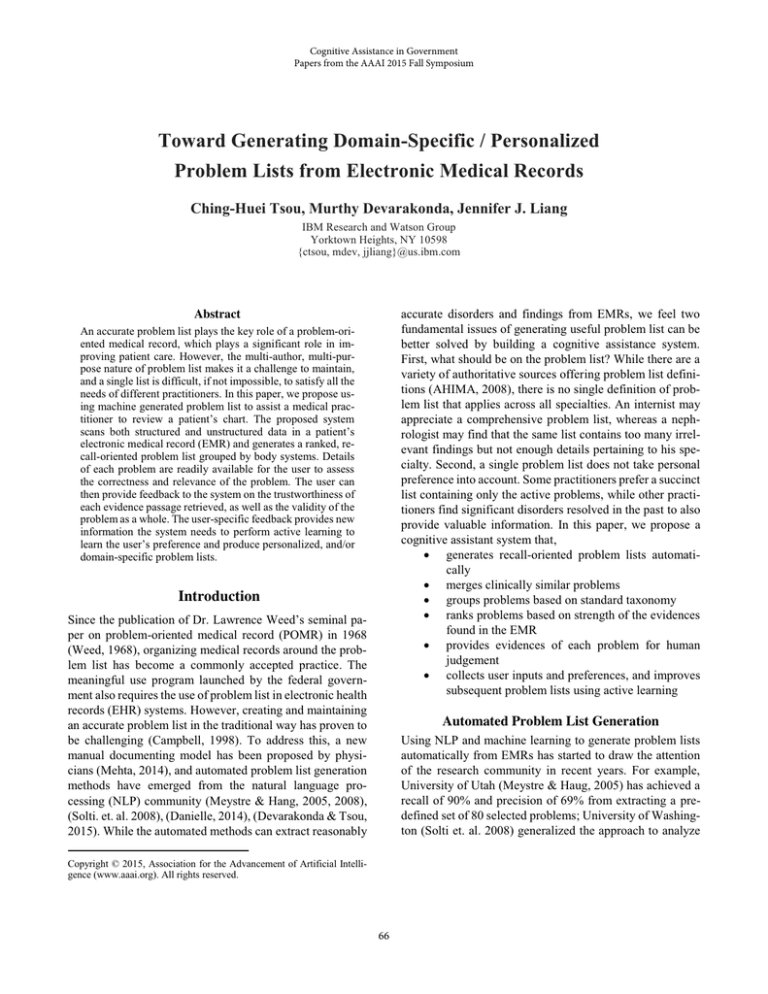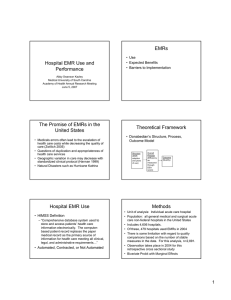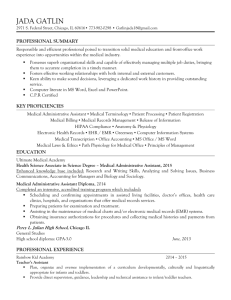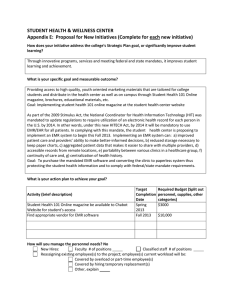
Cognitive Assistance in Government
Papers from the AAAI 2015 Fall Symposium
Toward Generating Domain-Specific / Personalized
Problem Lists from Electronic Medical Records
Ching-Huei Tsou, Murthy Devarakonda, Jennifer J. Liang
IBM Research and Watson Group
Yorktown Heights, NY 10598
{ctsou, mdev, jjliang}@us.ibm.com
Abstract
accurate disorders and findings from EMRs, we feel two
fundamental issues of generating useful problem list can be
better solved by building a cognitive assistance system.
First, what should be on the problem list? While there are a
variety of authoritative sources offering problem list definitions (AHIMA, 2008), there is no single definition of problem list that applies across all specialties. An internist may
appreciate a comprehensive problem list, whereas a nephrologist may find that the same list contains too many irrelevant findings but not enough details pertaining to his specialty. Second, a single problem list does not take personal
preference into account. Some practitioners prefer a succinct
list containing only the active problems, while other practitioners find significant disorders resolved in the past to also
provide valuable information. In this paper, we propose a
cognitive assistant system that,
x generates recall-oriented problem lists automatically
x merges clinically similar problems
x groups problems based on standard taxonomy
x ranks problems based on strength of the evidences
found in the EMR
x provides evidences of each problem for human
judgement
x collects user inputs and preferences, and improves
subsequent problem lists using active learning
An accurate problem list plays the key role of a problem-oriented medical record, which plays a significant role in improving patient care. However, the multi-author, multi-purpose nature of problem list makes it a challenge to maintain,
and a single list is difficult, if not impossible, to satisfy all the
needs of different practitioners. In this paper, we propose using machine generated problem list to assist a medical practitioner to review a patient’s chart. The proposed system
scans both structured and unstructured data in a patient’s
electronic medical record (EMR) and generates a ranked, recall-oriented problem list grouped by body systems. Details
of each problem are readily available for the user to assess
the correctness and relevance of the problem. The user can
then provide feedback to the system on the trustworthiness of
each evidence passage retrieved, as well as the validity of the
problem as a whole. The user-specific feedback provides new
information the system needs to perform active learning to
learn the user’s preference and produce personalized, and/or
domain-specific problem lists.
Introduction
Since the publication of Dr. Lawrence Weed’s seminal paper on problem-oriented medical record (POMR) in 1968
(Weed, 1968), organizing medical records around the problem list has become a commonly accepted practice. The
meaningful use program launched by the federal government also requires the use of problem list in electronic health
records (EHR) systems. However, creating and maintaining
an accurate problem list in the traditional way has proven to
be challenging (Campbell, 1998). To address this, a new
manual documenting model has been proposed by physicians (Mehta, 2014), and automated problem list generation
methods have emerged from the natural language processing (NLP) community (Meystre & Hang, 2005, 2008),
(Solti. et. al. 2008), (Danielle, 2014), (Devarakonda & Tsou,
2015). While the automated methods can extract reasonably
Automated Problem List Generation
Using NLP and machine learning to generate problem lists
automatically from EMRs has started to draw the attention
of the research community in recent years. For example,
University of Utah (Meystre & Haug, 2005) has achieved a
recall of 90% and precision of 69% from extracting a predefined set of 80 selected problems; University of Washington (Solti et. al. 2008) generalized the approach to analyze
Copyright © 2015, Association for the Advancement of Artificial Intelligence (www.aaai.org). All rights reserved.
66
one week’s worth of cardiology ambulatory progress notes
and extract problems found in certain sections within those
notes, achieving a recall of 88% and precision of 66%. To
the best of our knowledge, the IBM Watson-based system
(Devarakonda & Tsou, 2015) is the first successful automated problem list generation system that extracts an openended list of patient’s medical problems from the entire longitudinal EMR, which often contains hundreds of notes in
the course of several years. The current IBM Watson-based
system has a recall of 84% and precision of 53%. As there
is no shared corpus and the accuracy evaluation methodology varies, it is challenging to compare the accuracy among
the systems at this point.
The first category contains problems that are transient, minor, resolved in the past, or already covered by another problem, and problems that were considered or even diagnosed
by a physician but the supporting evidence found in the
EMR was too weak to be certain. The current system does
not model this well enough, but at the same time this category is well suited for a cognitive system as human judgment plays an important role. The second category contains
actual errors the system is making. Clinical notes in EMR
are nosier than most text, and we have made significant progress to reduce errors in this category, but this remains work
in progress. The third category is interesting. Although our
ground-truth problem lists have been carefully reviewed and
vetted, our system still finds real problems that are overlooked by the human experts. After using the system generated problem list to help vet the ground-truth, approximately
one new problem has been added to every two EMRs (an
average EMR in our training data has 6 problems). In the
clinical setting, a time-strapped physician will have less
time than our annotators to review the charts and will benefit
from a comprehensive automated problem list. All falsepositive problems from one of our testing EMRs are shown
in Table 3.
Problem
Error Type Comment
Abdominal pain
S1
finding
Anxiety state
S1
diagnosed, controlled
Headache
S1
finding
Anorectal fistula
S1
resolved (surgeries)
finding (related to abEpigastric pain
S1
dominal pain)
Infectious monoS1
acute / resolved
nucleosis
Anal fissure
S2
related to fistula
Crohn's disease
S3
questionable
"Do you have a hisAsthma
O3
tory of asthma?"
Chronic sinusitis
N1
true problem
Allergic rhinitis
N1
true problem
Ground-Truth Generation
358 longitudinal EMRs are currently used to train (278
EMRs) and test (the remaining 80) our system. Each EMR
was independently reviewed by two fourth year medical students, resulting in two separate problem lists that were then
adjudicated together with an MD. As a longitudinal EMR is
a rich source of information, reviewing a single EMR and
generating a comprehensive problem list requires 30
minutes in average per annotator – apparently a pure supervised learning method will not scale up.
Inter-annotator Agreement
Using the adjudicated result as ground-truth, the inter-annotator agreement accuracy are shown in Table 1.
AnnotaTP FP FN Recall
PreF1
tor
cision
A
334
27
98
0.78
0.93
0.84
B
461
53
61
0.88
0.90
0.89
C
427
31
44
0.91
0.93
0.91
Sum/Avg 1122 111 203
0.86
0.92
0.87
Table 1: Inter-Annotator Agreement
Note that the recall is comparable to our system but the precision is significantly higher.
Table 3: False-Positive Problems from an EMR
Error Analysis and Motivation
In the original ground-truth this patient has 9 problems.
Auto-generated problem list identified all of them (recall =
1.0) and 11 more (precision = 0.45). If we exam the 11 falsepositives closely, many of them provide useful information
and may be considered as true problems by some practitioners.
As the system recall is similar to human experts, we focused
our error analysis on finding the sources of false-positives.
The major sources of false-positives are shown in Table 2.
Error Category
Error Type
S1. transient problem
Subjective
S2. redundant problem
S3. hypothetical problem
O1. negation error
Objective
O2. abbreviation expansion error
O3. noise (template / checkbox)
Not an error
N1. ground-truth error
Cognitive Assistant Interface
The high percentage of subjective judgements observed in
our error analyses gives us strong motivation to build the
system as a cognitive assistant. The system first presents a
Table 2: Types of False-Positive Problems
67
recall-oriented problem list, trained using supervised learning, to the user. The list is ranked and clustered to reduce the
cognitive load of the user. Evidence of each problem is presented when the problem is selected. After reviewing the evidence passages, the user can provide feedback to the system, and the feedback will be used to train the system to
generate subsequent problem lists based on the user’s preference.
example, relations to active medications and abnormal test
results, are used by our model to score the problems but not
displayed in the current UI. While reviewing evidence for a
specific problem, the user can give feedback for each evidence passage retrieved by the system by clicking on the
checkboxes shown in Figure 3 to indicate if the evidence retrieved supports the problem indicated. After reviewing all
evidence for a selected problem, the user can then provide
feedback on the problem as a whole by clicking on the
checkboxes shown in Figure 1 and 2 to indicate if a problem
is considered incorrect, or correct but irrelevant to the particular provider.
Problem List User Interface
Screenshots of the prototype system are shown below. Figure 1 shows the initial problem list ordered by the system
generated confidence score. Higher score indicates stronger
evidence can be found in the EMR, and therefore the problem is more likely to be a true and relevant problem of this
patient.
Figure 3: Evidences of Selected Problem
Active Learning
Figure 1: Problem List
The initial problem list is generated using supervised learning. The drawback of using supervised learning is, 1.)
Ground-truth is time consuming to generate 2.) Groundtruth represents one particular view / definition of the problem list, which is not necessarily aligned with every practitioner. Both problems can be overcome by active learning,
and the proposed cognitive assistant UI provides a natural
way to interactively query the user to obtain the desired outputs at new data points. As the problems are ranked by the
system’s confidence, data collected on this actively selected
set is most informative, in terms of error-based active learning where the goal is to reduce the predictive error.
Problems marked by a user as incorrect or irrelevant will be
hidden from view the next time the same user opens the
same EMR – no learning required. This user-specific data
will also be used to train a user-specific model that learns
the user’s preference and ranks problems in other EMRs accordingly. Problems marked by multiple users as incorrect
or irrelevant will be used as ground-truth to improve the initial problem lists generated using supervised algorithms.
Figure 2 shows the same list now grouped by a SNOMED
CT category (Disorder of body system). When related problems are clustered, redundant findings become less bothersome and in some cases actually provide additional information.
Figure 2: Clustered Problem List
Figure 3 shows how evidence passages are displayed when
a problem is selected. A problem is often discussed in multiple notes. In addition to the metadata, such as the note date
and provider name, the system also inferences the note type
and note section to provide the user more context without
opening-up the actual note. Currently only evidence found
in clinical notes are displayed. Other types of evidence, for
Conclusion and Future Work
A patient is often treated by multiple providers, and this
makes problem lists inherently multidimensional. A single,
static problem list, whether manually maintained or automatically generated, will not satisfy all providers’ needs.
68
Building on top of our state-of-the-art problem list generation algorithm, we propose a cognitive assistant that uses active learning to build specialty-specific and personalized
problem lists. The proposed system is summarized in Figure
4. The design goal of the initial problem list is to help physicians to not miss any problems, i.e., a recall-oriented system. This is because it is much harder for a physician to create a comprehensive problem list than to verify if a particular problem is correct and relevant. To reduce the cognitive
load on the user, the list can be easily sorted by any attribute
and grouped based on standard taxonomy, and evidence of
the problems are readily available for the user to review.
The cognitive assistant not only presents the initial lists, but
also actively requests user inputs for problems with higher
ranking to obtain the most informative training data, and
then employs the feedback to produce more accurate, and
more personalized problem lists.
is the user likes to see. With the proposed cognitive extension to our problem list generation engine, the system provides straightforward mechanisms for providers to review
patients’ charts, keeps the users in the feedback loop, and
automatically improves the problem lists’ accuracy based on
the individual and aggregated response.
References
Weed, L. L., (1968). Medical Records That Guide and Teach. New
England Journal of Medicine, March. pp. 652-657.
Campbell, J. R., (1998). Strategies for Problem List Implementation in a Complex Clinical Enterprise. Proc AMIA Symp 285-9.
Mehta, Neil, Vakharia, Nirav, and Wright, Adam, (2014) Mar.
EHRs in a Web 2.0 World: Time to Embrace a Problem-List Wiki,
J Gen Intern Med. 29(3): 434–436.
Meystre, S. and Haug, P. J., (2005). Automation of a Problem List
using Natural Language Processing. BMC Medical Informatics
and Decision Making, 5(30).
Meystre, S. and Haug, P. J., (2005). Evaluation of Medical Problem Extraction from Electronic Clinical Documents using MetaMap Transfer (mmtx). Stud Health Technol Inform, 116:823-828.
Solti, I., Aaronson, B., Fletcher, G., Solti, M., Gennari, J. H.,
Cooper, M., & Payne, T. (2008). Building an Automated Problem
List Based on Natural Language Processing: Lessons Learned in
the Early Phase of Development. AMIA Annual Symposium Proceedings, 2008, 687–691.
Mowery, Danielle (2014) Developing a Clinical Linguistic Framework for Problem List Generation from Clinical Text. Doctoral
Dissertation, University of Pittsburgh.
Devarakonda, Murthy & Tsou, Ching-Huei, (2015), Automated
Problem List Generation from Electronic Medical Records in IBM
Watson, Innovative Applications of Artificial Intelligence (IAAI15).
AHIMA Best Practices for Problem Lists in an EHR Work Group,
2008, Best Practice for Problem Lists in an EHR. Appendix A: Definitions of Problem Lists from Authoritative Sources, Journal of
AHIMA 79, no. 1: 73-77 (expanded online addition).
Figure 4: Cognitive Assistant for Problem List Generation
The core problem list generation engine itself is a work in
progress, and any improvement made in the core algorithm
will have direct impact on the cognitive assistant. Deploying
the proposed cognitive assistant to the annotators and practitioners will also help gather instructive training data that is
costly to obtain otherwise.
Currently only evidence found in clinical notes are presented in the user interface when a problem is selected.
However, physicians often consider test results to be the primary data when other evidence from clinical notes are controversial. Many types of structured data, including lab tests,
are considered as a whole in the problem list model, but the
instance level accuracy is not yet accurate enough to be displayed as evidence. Higher accuracy in relation detection is
an active area we are pursuing. The user interface, as of the
time of writing, is a proof-of-concept prototype. To support
better personalized features, a full-fledged user management
system is needed.
The concept of applying active learning in recommender
systems has shown great success in many large scale consumer facing systems, such as Netflix, Amazon, and Facebook. Similar to problem lists, recommender systems often
have an ill-defined or open-ended objective - to find what it
69





